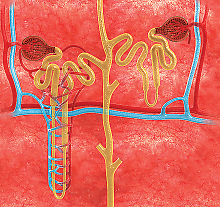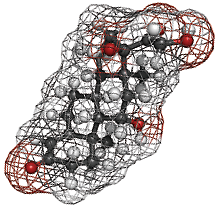Journal Digest
Urinary Metabolites May Help Differentiate BD From MDD

To develop a potentially more objective test for diagnosing bipolar depression (BD), a research team from Chongqing Medical University in China used various chromatography tools to profile the urine samples from 76 patients with major depressive disorder (MDD), 43 patients with BD, and 126 controls to identify any distinct metabolite patterns among these groups.
They uncovered a panel of six urinary metabolites that could serve as biomarkers: propionate, formate, 2,3-dihydroxybutanoic acid, 2,4-dihydroxypyrimidine, phenylalanine, and β-alanine. They tested this panel on a second group of 50 MDD and 28 BD patients and found they could distinguish the two conditions with about 90 percent accuracy.
Though preliminary, these findings do point to the validity of using metabolite profiling as a method of diagnosing mental disorders. The study was published in the Journal of Proteome Research.
Chen J, Zhou C, Liu Z, et al. Divergent Urinary Metabolic Phenotypes Between Major Depressive Disorder and Bipolar Disorder Identified by a Combined GC-MS and NMR Spectroscopic Metabonomic Approach. J Proteome Res. Aug 7, 2015; 14(8): 3382-9.
Cortisol Can Reduce Cravings in Some Drug Users

Stress has been found to increase cravings and is a risk factor for drug addiction or relapse. A new clinical study appearing in Translational Psychiatry tested whether the stress hormone cortisol might influence drug craving in people recovering from heroin addiction.
A total of 29 patients in a heroin-assisted treatment program were randomly divided to receive either 20 mg of oral cortisol or placebo 105 minutes prior to their daily drug administration, and their craving levels were measured at periodic intervals.
Cortisol was found to significantly reduce cravings in those patients who received a low dose of daily heroin (up to 305 mg), but it had no effect on medium- and high-dose patients. Cortisol also showed no effects on secondary outcomes of anxiety, anger, and withdrawal symptoms.
The study authors suggested that future studies should search for the factors that may influence cortisol’s effects on craving and whether the drug reduces cravings and relapse in drug-abstinent patients.
Walter M, Bentz D, Schicktanz N, et al. Effects of Cortisol Administration on Craving in Heroin Addicts. Transl Psychiatry. Jul 28, 2015; 5: e610.
Elevated Glutamate Receptors Found In Women With Depression

A post-mortem analysis of brain tissue suggests that women with depression may have higher levels of several genes that regulate the neurotransmitter glutamate than women without depression. Three other glutamate-related genes were also found to be elevated in depressed patients—male and female—who had died by suicide.
Monsheel Sodhi, Ph.D., at the University of Illinois at Chicago and her colleagues examined a large cohort of brain tissue samples and identified higher expression levels of eight genes (GRIN1, GRIN2A-D, GRIA2-4, GRIK1-2, GRM1, GRM4, GRM5, and GRM7) in the dorsolateral prefrontal cortex in women with major depressive disorder compared with control females. Men and women with depression who died by suicide had elevated levels of GRIN2B, GRIK3, and GRM2 expression.
The higher elevation of glutamate expression in women may help to explain why women have a higher risk of suicide than men. The findings also help to explain why ketamine—which inhibits the glutamate-binding NMDA receptor—can rapidly eliminate depression symptoms.
As this study uncovered a wide range of glutamate receptors that may play a role in depression, it suggests that other agents besides ketamine might also have uses as rapid-onset antidepressants.
This study was published in Molecular Psychiatry.
Gray A, Hyde T, Deep-Soboslay A et al. Sex Differences in Glutamate ReceptorGene Expression in Major Depression and Suicide. Mol Psychiatry. July 14, 2015 [Epub ahead of print].
Teens With Healthy Attitudes May Protect Others From Depression

Teens with healthy attitudes may have the potential to ward off depression in their friends, according to study published in Proceedings of the Royal Society B.
Researchers from Warwick Medical School and University of Manchester in the United Kingdom gathered data from more than 2,000 U.S. high school students enrolled in the National Longitudinal Study of Adolescent to Adult Health to examine how the moods of teenagers influence the moods of their closest friends. Individuals were classified as either having depressive symptoms (low mood) or not being depressed (healthy mood), based on the Center for Epidemiologic Studies Depression Scale. Methods for detecting how the teens’ moods influenced each other were modeled after methods used to track the spread of infectious diseases.
According to the model, adolescents who have five or more friends with healthy mood were 50 percent less likely to become depressed over a six- to 12-month period than their counterparts with no friends with healthy mood. Having 10 friends with healthy attitudes doubled the probability of recovering from depressive symptoms compared with adolescents with three friends with healthy attitudes.
“It could be that having a stronger social network is an effective way to treat depression,” Thomas House, Ph.D, M.D., a coauthor and a senior lecturer in applied mathematics at Manchester, said in a press release.
Hill E, Griffiths F, and House T. Spreading of Healthy Mood in Adolescent Social Networks. Proc Biol Sci. 2015; 282(1813).
Military Women Are at No Greater Risk of Developing PTSD Than Men

While past research on gender differences in the onset of posttraumatic stress disorder (PTSD) among U.S. veterans has been mixed, a recent study by the departments of Defense and Veterans Affairs suggests that women in the military are at no greater risk of developing PTSD than their male counterparts who experience similar traumatic events.
The study included more than 2,300 pairs of men and women in the military who were matched based on an array of variables—including combat exposure, alcohol misuse, depression, and sexual assault—and surveyed on PTSD symptoms over an average time span of seven years (from 2001 to 2008). All participants had been deployed at least once to Iraq or Afghanistan and did not show signs of PTSD at the study’s initiation. Outcome measures included a positive screen for PTSD and symptom severity scores measured by the PTSD Patient Checklist-Civilian Version.
The results, published in the Journal of Psychiatric Research, showed that 6.7 percent of women and 6.1 percent of men developed PTSD—a difference that was not statistically significant. There was also no difference in the severity of PTSD symptoms among men and women who developed the disorder.
According to the authors, the current study suggests that gender alone is not an indicator of PTSD risk.
Jacobson I, Donoho C, Crum-Cianflone N, et al. Longitudinal Assessment of Gender Differences in the Development of PTSD Among U.S. Military Personnel Deployed in Support of the Operations in Iraq and Afghanistan. J Psychiatr Res. 2015; 68:30-6.
Nine Modifiable Risk Factors May Contribute to Alzheimer’s

Recent analysis by researchers at the University of California, San Francisco, highlights nine modifiable risks that may contribute to Alzheimer’s disease.
Out of almost 17,000 articles, the researchers focused their analysis on 323 articles that identified 93 different potential risks for Alzheimer’s disease in more than 5,000 people.
Nine risk factors, including obesity, current smoking, carotid artery narrowing, type 2 diabetes, high levels of homocysteine, depression, high blood pressure, frailty, and low educational attainment were associated with Alzheimer’s disease. In contrast, estrogen, statins, antihypertensive medications, and non-steroidal anti-inflammatory drugs as well as dietary exposures to folate, vitamin E, vitamin C, and coffee served as protective factors against the onset of Alzheimer’s disease.
The researchers noted that though no definitive conclusions can be drawn about cause and effect, the findings suggest that preventive strategies targeting diet, prescription drugs, body chemistry, mental health, underlying disease, and lifestyle may serve as beneficial tools in helping to curb the number of new cases of Alzheimer’s disease.
Xu W, Tan L, Wang H, et al. Meta-Analysis of Modifiable Risk Factors for Alzheimer’s Disease. J Neurol Neurosurg Psychiatry. 2015; pii: jnnp-2015-310548. doi: 10.1136/jnnp-2015-310548. [Epub ahead of print] 8
Young Adults Perceive Hookah, E-Cigarettes as Safer Than Cigarettes

A new study published in Health Education & Behavior shows that people under the age of 25 believe that vaporized nicotine products, such as hookah and electronic cigarettes, are safer than conventional cigarettes.
For the study, the researchers collected data from almost 3,000 smoking and nonsmoking young adults aged 18 to 34. They found that approximately 58 percent of all respondents believed e-cigarettes to be less risky than cigarettes, while 25 percent reported hookah to be less risky than cigarettes. In comparison, 14 percent rated cigars and 7 percent rated smokeless tobacco as less risky.
When separating perceptions by age group, the researchers found that 62.1 percent of the participants aged 18 to 24 perceived e-cigarettes as less risky than cigarettes compared with 54.6 percent of 25 to 34 year olds perceiving e-cigarettes to be less risky. In addition, 32.7 percent of those aged 18 to 24 believed hookah to be less risky than cigarettes compared with 18.5 percent of participants aged 25 to 34.
The researchers noted that discrepancies in perceptions among the two age groups may be associated with different advertising messages the groups are exposed to, and in the case of e-cigarettes, a possible inclination for younger people to attribute more positive feelings toward newer products. ■
Wackowski O, Delnevo C. Young Adults’ Risk Perceptions of Various Tobacco Products Relative to Cigarettes: Results From the National Young Adult Health Survey. Health Education & Behavior. August 24, 2015 [Epub ahead of print].



